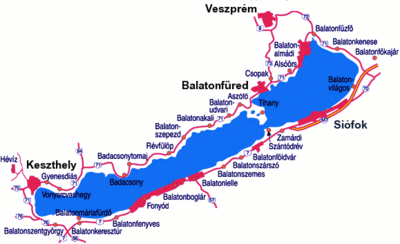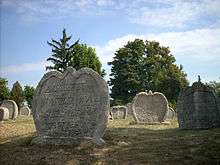Lake Balaton
| Lake Balaton | |
|---|---|
 | |
|
Location of Lake Balaton within Hungary | |
| Location | Hungary |
| Coordinates | 46°50′N 17°44′E / 46.833°N 17.733°ECoordinates: 46°50′N 17°44′E / 46.833°N 17.733°E |
| Type | Rift lake |
| Primary inflows | Zala River |
| Primary outflows | Sió |
| Catchment area | 5,174 km2 (1,998 sq mi)[1] |
| Basin countries | Hungary |
| Max. length | 77 km (48 mi) |
| Max. width | 14 km (8.7 mi) |
| Surface area | 592 km2 (229 sq mi) |
| Average depth | 3.2 m (10 ft) |
| Max. depth | 12.2 m (40 ft) |
| Water volume | 1.9 km3 (0.46 cu mi) |
| Residence time | 2 years |
| Shore length1 | 236 km (147 mi) |
| Surface elevation | 104.8 m (344 ft) |
| Settlements | Keszthely, Siófok, Balatonfüred (see list) |
| 1 Shore length is not a well-defined measure. | |
Lake Balaton (German: Plattensee) is a freshwater lake in the Transdanubian region of Hungary. It is the largest lake in Central Europe,[2] and one of the region's foremost tourist destinations. The Zala River provides the largest inflow of water to the lake, and the canalised Sió is the only outflow.
The mountainous region of the northern shore is known both for its historic character and as a major wine region, while the flat southern shore is known for its resort towns. Balatonfüred and Hévíz developed early as resorts for the wealthy, but it was not until the late 19th century when landowners, ruined by Phylloxera attacking their grape vines, began building summer homes to rent out to the burgeoning middle classes.[3]
Name
In Hungarian, the lake is known simply as Balaton. It was called lacus Pelsodis or Pelso by the Romans.[4] The name is Illyrian, and therefore Indo-European (cf. Czech pleso ‘sinkhole, deep end of a lake’), later replaced by the Slavic *bolto (cf. Serbo-Croatian blȁto, Czech bláto) meaning 'mud, swamp' (from earlier Proto-Slavic boltьno, Slovene: Blatno jezero,[5][6] Slovak: Blatenské jazero[7]). Slavic prince Pribina began to build in January 846 a fortress as his seat of power and several churches in the region of Lake Balaton, in a territory of modern Zalavár surrounded by forests and swamps along the river Zala.[8][9][10] His well fortified castle and capital of Balaton Principality that became known as Blatnohrad or Moosburg ("Swamp Fortress") served as a bulwark both against the Bulgarians and the Moravians.[8][9][10]
The German name for the lake is Plattensee.[11] It is unlikely that the Germans named the lake so for being shallow since the adjective platt is a Greek loanword that was borrowed via French and entered the general German vocabulary in the 17th century.[12][13] It is also noteworthy that the average depth of Balaton (3.2 m [10 ft])[14] is not extraordinary for the area (cf. the average depth of the neighbouring Neusiedler See, which is roughly 1 m [3.3 ft]).[15]
Climate

Lake Balaton affects the local area precipitation every year. The area receives approximately 5–7 cm (2–3 in) more precipitation than most of Hungary, resulting in more cloudy days and less extreme temperatures. The lake's surface freezes during winters. The microclimate around Lake Balaton has also made the region ideal for viticulture. The Mediterranean-like climate, combined with the soil (containing volcanic rock), has made the region notable for its production of wines since the Roman period two thousand years ago.[16]
History
While a few settlements on Lake Balaton, including Balatonfüred and Hévíz, have long been resort centres for the Hungarian aristocracy, it was only in the late 19th century that the Hungarian middle class began to visit the lake.[17] The construction of railways in 1861 and 1909 increased tourism substantially, but the post-war boom of the 1950s was much larger.
The last major German offensive of World War II, Operation Frühlingserwachen, was conducted in the region of Lake Balaton in March 1945, being referred to as "the Lake Balaton Offensive" in many British histories of the war. The battle was a German attack by Sepp Dietrich's Sixth Panzer Army and the Hungarian Third Army between 6 March and 16 March 1945, and in the end, resulted in a Red Army victory. Several Ilyushin Il-2 wrecks have been pulled out of the lake after having been shot down during the later months of the war.
During the 1960s and 1970s, Balaton became a major tourist destination for ordinary working Hungarians and especially for subsidised holiday excursions for union members. It also attracted many East Germans and other residents of the Eastern Bloc. West Germans could also visit, making Balaton a common meeting place for families and friends separated by the Berlin Wall until 1989.[18] The collapse of the Soviet Union after 1991 and the dismantling of the unions saw the gradual but steady reduction in numbers of lower-paid Hungarian visitors.
Tourism
The major resorts around the lake are Siófok, Keszthely, and Balatonfüred. Zamárdi, another resort town on the southern shore, has been the site of Balaton Sound, a notable electronic music festival since 2007. Balatonkenese has hosted numerous traditional gastronomic events. Siófok is known for attracting young people to it because of its large clubs. Keszthely is the site of the Festetics Palace and Balatonfüred is a historical bathing town which hosts the annual Anna Ball.
The peak tourist season extends from June until the end of August. The average water temperature during the summer is 25 °C (77 °F), which makes bathing and swimming popular on the lake. Most of the beaches consist of either grass, rocks, or the silty sand that also makes up most of the bottom of the lake. Many resorts have artificial sandy beaches and all beaches have step access to the water. Other tourist attractions include sailing, fishing, and other water sports, as well as visiting the countryside and hills, wineries on the north coast, and nightlife on the south shore. The Tihany Peninsula is a historical district. Badacsony is a volcanic mountain and wine-growing region as well as a lakeside resort. The lake is almost completely surrounded by separated bike lanes to facilitate bicycle tourism. Although the peak season at the lake is the summer, Balaton is also frequented during the winter, when visitors go ice-fishing or even skate, sledge, or ice-sail on the lake if it freezes over.
Sármellék International Airport provides air service to Balaton (although most service is only seasonal).
Other resort towns include: Balatonalmádi, Balatonboglár, Balatonlelle, Fonyód and Vonyarcvashegy.
Towns and villages

North shore
From east to west:
Balatonfőkajár - Balatonakarattya - Balatonkenese - Balatonfűzfő - Balatonalmádi - Alsóörs - Paloznak - Csopak - Balatonarács - Balatonfüred - Tihany - Aszófő - Örvényes - Balatonudvari - Fövenyes - Balatonakali - Zánka - Balatonszepezd - Szepezdfürdő - Révfülöp - Pálköve - Ábrahámhegy - Balatonrendes - Badacsonytomaj - Badacsony - Badacsonytördemic - Szigliget - Balatonederics - Balatongyörök - Vonyarcvashegy - Gyenesdiás - Keszthely
South shore
From east to west:
Balatonakarattya - Balatonaliga - Balatonvilágos - Sóstó - Szabadifürdő - Siófok - Széplak - Zamárdi - Szántód - Balatonföldvár - Balatonszárszó - Balatonszemes - Balatonlelle - Balatonboglár - Fonyód - Bélatelep - Balatonfenyves - Balatonmáriafürdő - Balatonkeresztúr - Balatonberény - Fenékpuszta

Gallery



 The estuary of Zala river
The estuary of Zala river
.jpg) Balaton in Winter
Balaton in Winter
 Balaton as seen from Alsórét, Balatonkenese
Balaton as seen from Alsórét, Balatonkenese
- Castle at Szigliget


- Golden bridge - Balatonkenese
See also
References
- ↑ Herschy, Reginald W.; Fairbridge, Rhodes W. (1998). Encyclopedia of Hydrology and Lakes. Springer Publishing. ISBN 978-0-412-74060-2. Retrieved August 22, 2012.
- ↑ "Lake Balaton". Encyclopædia Britannica. Retrieved 2008-03-20.
- ↑ "History of Lake Balaton - Lonely Planet Travel Information". Lonelyplanet.com. Retrieved January 2014. Check date values in:
|access-date=(help) - ↑ Brill's New Pauly: encyclopaedia of the ancient world - Hubert Cancik, Helmuth Schneider, David E. Orton - Google Knihy. Books.google.com. Retrieved January 2014. Check date values in:
|access-date=(help) - ↑ Historical review - Google Knihy. Books.google.com. 2009-01-06. Retrieved January 2014. Check date values in:
|access-date=(help) - ↑ A bulwark against Germany: the fight of the Slovenes, the western branch of ... - Bogumil Vošnjak, Fanny S. Copeland - Google Knihy. Books.google.com. Retrieved January 2014. Check date values in:
|access-date=(help) - ↑ Dejiny slovenského jazyka - Ján Stanislav - Google Knihy. Books.google.com. Retrieved January 2014. Check date values in:
|access-date=(help) - 1 2 Bartl 2002, p. 19.
- 1 2 Róna-Tas 1999, p. 243.
- 1 2 Goldberg 2006, p. 85.
- ↑ "Urlaub in Ungarn - Ferienwohnung Ferienhaus am Plattensee in Ungarn". Weltweit-urlaub.de. Retrieved January 2014. Check date values in:
|access-date=(help) - ↑ Etymologisches Wörterbuch der deutschen Sprache, 24. Aufl., s. v.
- ↑ "the Grimm dictionary". Woerterbuchnetz.de. Retrieved January 2014. Check date values in:
|access-date=(help) - ↑ Archived July 16, 2012, at the Wayback Machine.
- ↑ Archived May 15, 2012, at the Wayback Machine.
- ↑ Archived October 13, 2007, at the Wayback Machine.
- ↑ Lake Balaton History at Lonely Planet
- ↑ "German unity at Lake Balaton – a European history". Dortmund.de. Retrieved January 2014. Check date values in:
|access-date=(help)
External links
| Wikivoyage has a travel guide for Lake Balaton. |
| Wikimedia Commons has media related to Balaton. |
| Wikisource has the text of the 1911 Encyclopædia Britannica article Balaton. |
-
 "Balaton". Encyclopedia Americana. 1920.
"Balaton". Encyclopedia Americana. 1920. -
 "Balaton, Lake". New International Encyclopedia. 1905.
"Balaton, Lake". New International Encyclopedia. 1905. -
 "Balaton, Lake". The American Cyclopædia. 1879.
"Balaton, Lake". The American Cyclopædia. 1879.
- Balaton at funiq.hu
- Tourism ( what to do and what to see at Lake Balaton )